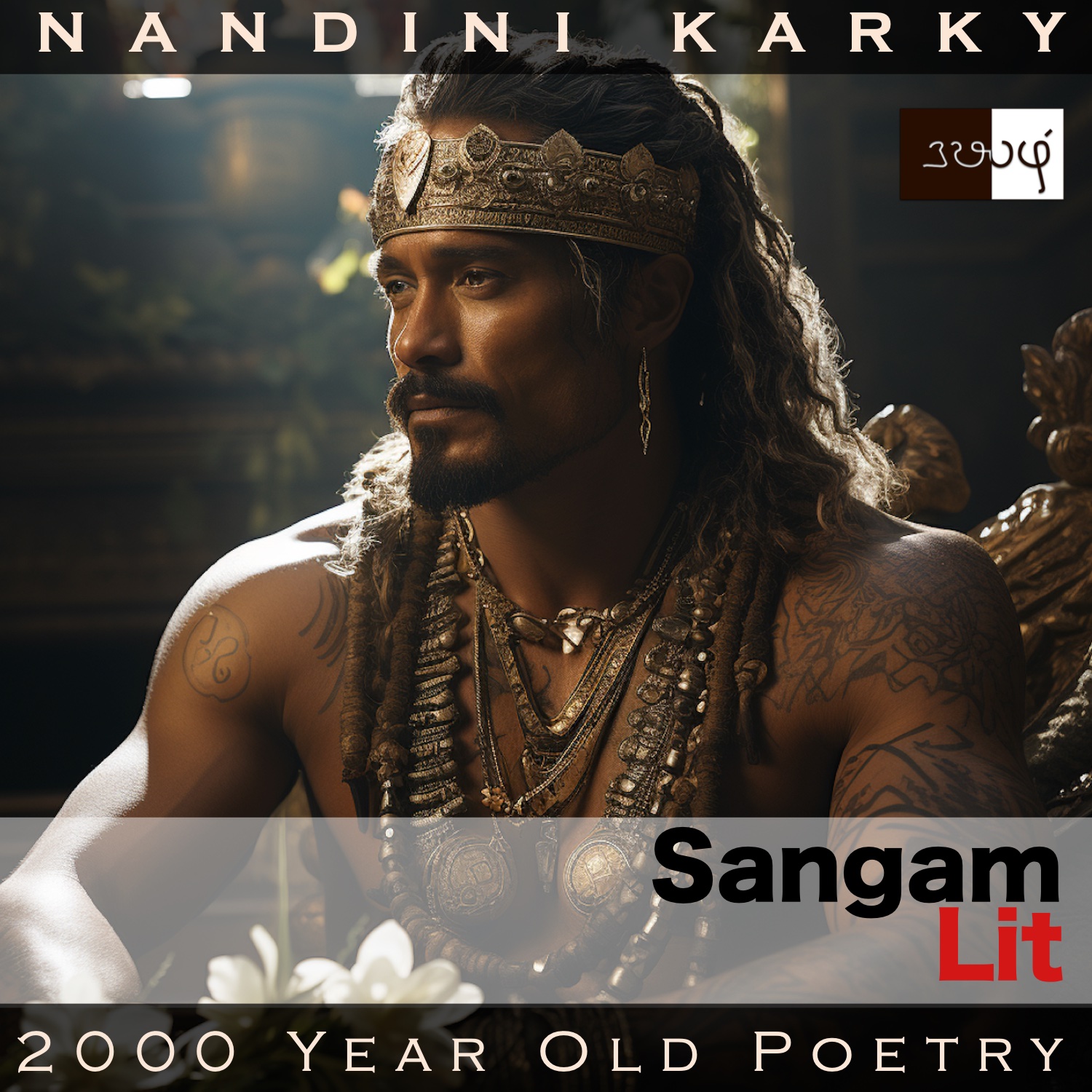Podcast: Play in new window | Download
Subscribe: Apple Podcasts | Spotify | Amazon Music | Android | iHeartRadio | Email | TuneIn | RSS | More
In this episode, we perceive a person’s unceasing courage, as portrayed in Sangam Literary work, Puranaanooru 283, penned by the poet Andar Nadum Kallinaar. Set in the category of ‘Thumbai Thinai’ or ‘Battle of two kings’, the verse echoes the events in the life of a valorous warrior.

ஒண் செங் குரலித் தண் கயம் கலங்கி,
வாளை நீர்நாய் நாள் இரை பெறூஉப்
பெறாஅ உறை அரா வராஅலின் மயங்கி
மாறு கொள் முதலையொடு ஊழ் மாறு பெயரும்
அழும்பிலன் அடங்கான் தகையும் என்றும்,
வலம் புரி கோசர் அவைக் களத்தானும்,
மன்றுள் என்பது கெட… தானே பாங்கற்கு
ஆர் சூழ் குறட்டின் வேல் நிறத்து இங்க,
உயிர் புறப்படாஅ அளவைத் தெறுவர,
தெற்றிப் பாவை திணி மணல் அயரும்
மென் தோள் மகளிர் நன்று புரப்ப,
இமிழ்ப்புற நீண்ட பாசிலைக்
கமழ் பூந் தும்பை நுதல் அசைத்தோனே.
A verse that celebrates a fighting spirit. The poet’s words can be translated as follows:
“Disturbing the moist and still waters filled with radiant, red kurali vines, the otter nabs its day prey of a river fish. Not satisfied with that, it pounces on a snake thinking that it’s a murrel fish, and then fights with a crocodile in that town of ‘Alumbil’. Here lives the untameable leader, who always has a place of honour in the assembly of the victorious Kosars. Disregarding his central, well-protected position, he went to the aid of his friend, and took arrows to his wide chest, which appear like the spokes on a wheel, and he stood there, furious, even as his life refused to part away. When he returned, soft-armed women, who carve mud dolls in the shore sand, took good care of him. And now, he takes the fragrant ‘thumbai’ flowers, with its long and luxuriant leaves, and ties that around his forehead!”
Let’s explore the nuances here. The poet starts describing a place vividly in the style of ‘Aham’ poems. He mentions how an otter is leaping into still waters filled with red vines and catching the ‘vaalai’ fish. Finding not satisfaction in its catch, the otter then leaps at what it thinks as ‘varaal’ fish but which happens to be a snake. The confusion of this otter is quite understandable if we glance at the full name of this fish, which happens to be ‘snakehead murrel fish’. Moving on, this otter, as if not having enough adventure, then ventures to put a fight with a crocodile, the poet says, and reveals all this happens in the town of ‘Alumbil’. This happens to be the domain of the leader being sung about, someone described as ‘uncontrollable’ to sketch his wild and fierce nature. The poet turns to mention the status of this leader in the great courts of the ever-victorious Kosar kings.
After all these inputs about the warrior’s background, the poet turns to what transpired just then, which is the way this leader disregarded his own safety and went to the aid of a friend and took arrows many to his chest. This image the poet graphically illustrates as the spokes on a wheel. Continuing the story, the poet says that his life seemed to hold on strong, despite these adversities. So, when the leader returned home, his young women took good care of him and healed him, so that he now takes a cluster of ‘thumbai’ flowers and wears around his forehead, signifying that he’s ready to face the fury of the battle again. If we reflect on it, the initial description of the otter’s antics in the water now sound like a metaphor for this leader, who also seems to be someone who cannot get enough of the battle! Even after all those fatal wounds, he’s gearing up to return again to the battlefront, the poet connects. To me, this verse seemed to be a summary of themes in the the recent few verses, such as the one where a man goes valiantly to defend his friend in Puranaanooru 275, and the one where the wife tries to heal her husband with all the right remedies in Puranaanooru 281. A verse that symbolises the respect accorded by Sangam people to the spirit of resilience. ‘No matter how deep you fall, you can soar above it all’ seems to be the thought that reverberates here!




Share your thoughts...